
11 minute read
Tackling Dust Formation, Case-By-Case


CASE-BY-CASE CASE-BY-CASE
Joan Riaza, Kao Chemicals Europe,
Spain, shows that identifying the main reason for dust formation in each individual occurence is crucial to determining the best solution.
Dust formation is one of the biggest problems associated with solid fertilizers, particularly for granular types that are stored in bulk in large warehouses. Handling them in such an setting can affect workers’ health and the environment.
There are several reasons, which will be covered in this article, that explain dust generation in granular fertilizers: granule morphology, climatic conditions, post-reactions and caking formation.
Different technical solutions to this issue have been proposed over time, considering the origin of the problem, the fertilizer composition and the fi nal usage.
Present and future environmental demands call for a review of current anti-dusting technologies and the proposal of new ones, as will be discussed.
Main reasons for dust formation
Granule morphology
The granulation process can produce more or less spherical granules, with more or less smooth surfaces. The appearance of the fi nal product will depend on the raw materials and the specifi c granulation mechanism.1
If a homogeneous slurry that contains all components of the fertilizer is being used and the granulation process involves layering one or several solid components over a seed, the granules fi nally obtained present a low abrasion capacity.
However, if a signifi cant quantity of solid components is added to the granulation process by means of an agglomeration process, where only a part is a homogeneous liquid mass, the granules obtained will present a high abrasion capacity (Figure 1).


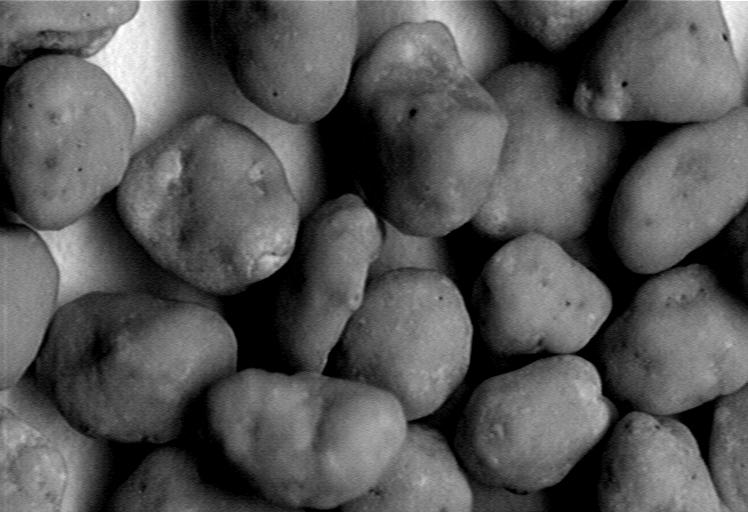

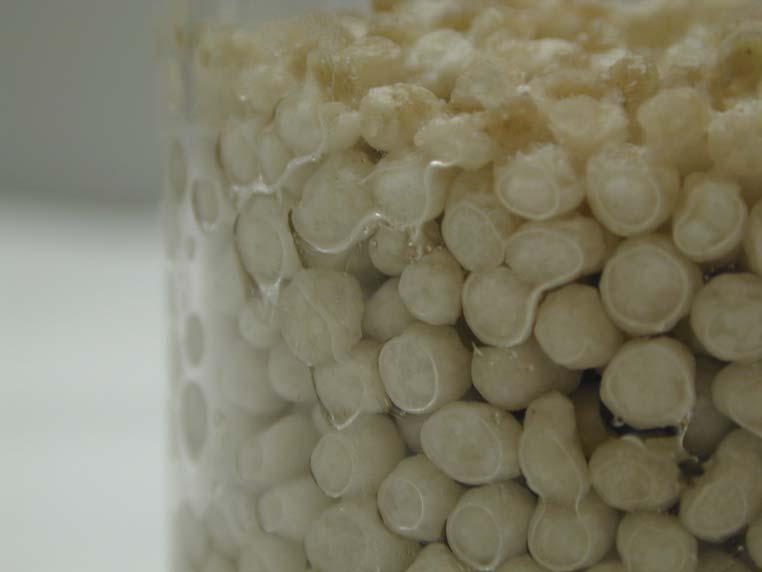
Post-reactions
In many granulation processes, especially when the mass of granules is heterogeneous, reactions continue in the granules and Figure 1. (right). NPK 15-15-15, low abrasion capacity (left), and NPK 15-15-15, high abrasion capacity on the surface. New salts can be generated, while degradation and dust formation can occur as well. Water content plays an important role in this process. A typical example of this phenomenon is the post-reaction of NPK granules based on either ammonium nitrate and potassium chloride or ammonium sulfate and potassium chloride. Figure 3 shows XR mapping of an NPK based mainly on ammonium sulfate, mono/diammonium phosphate and potassium chloride. Because of these post-reactions some new crystals are formed on the surface of the granules. If these crystals are fragile, dust formation occurs easily when granules are manipulated. Figure 4 shows fragile crystals on granule surfaces. Figure 2. Detail of ammonium nitrate moisture absorption at laboratory scale in a climatic chamber. Figure 3. XR mapping – potassium (left). NPK with heterogeneous mass. More post-reactions. XR mapping – sulfur (right). NPK with heterogeneous mass. More post-reactions.
Caking formation
Caking occurs due to several possible reasons, some (but not all) of which are the same as the causes of dust formation: climatic conditions and post-reactions. Another possible cause, however, is the deformation of the granules when submitted to high pressures. When a caked fertilizer mass is forced to be separated again, dust formation occurs from the areas of intersection.
Figure 5 shows instances where post-reactions were the main cause of caking.
Climatic conditions
Depending on the components present in the fertilizer, the critical relative humidity will be higher or lower. For instance, NPK fertilizers based on ammonium nitrate or urea can start to absorb moisture at a quite low relative humidity. Moisture can enter into the granules; later, when the granules are subjected to conditions of low humidity, moisture will be released, encouraging recrystallisation of salts on the surface of the granules as well as dust formation (Figure 2).
Changes in storage temperatures can also promote crystal phase transitions – for instance, in ammonium nitrate a temperature change can alter the crystal state, promoting density changes that cause degradation of the granules.
Effect of anti-caking additives
In many cases, granular fertilizers are coated with a double treatment of an anti-caking additive mainly based on hydrocarbons, surfactants and an inorganic powder (talcum being the most common). Talcum is very useful for minimising the likelihood of caking, but the selection of a good-quality talcum and anti-caking formulation is essential to obtaining a satisfactory talcum adhesion on the granular surface. A bad selection, on the other hand, can promote the release of dust.
In addition, depending on the compositions of the fertilizer and anti-caking formulation, some extra dust formation can be generated.
In summary, anti-caking additives must be selected carefully.
Dust evaluation at laboratory scale
Different methods have been proposed to measure dust formation. One of the most popular is the Dedusting Tower (Method IFDC S-122, International Fertilizer Development

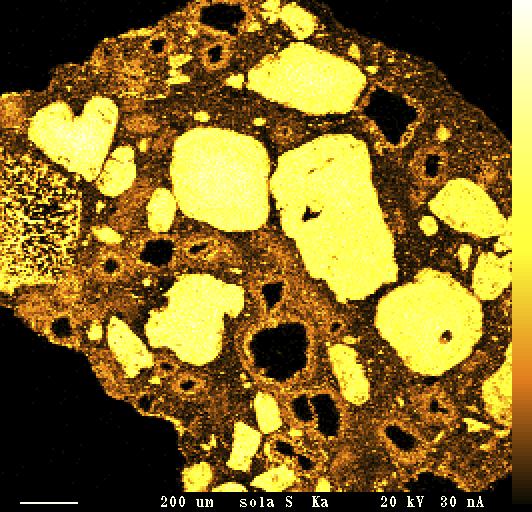

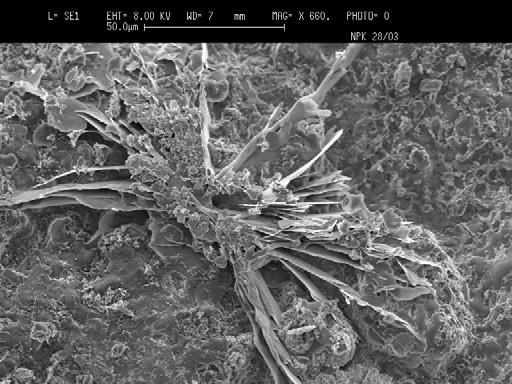
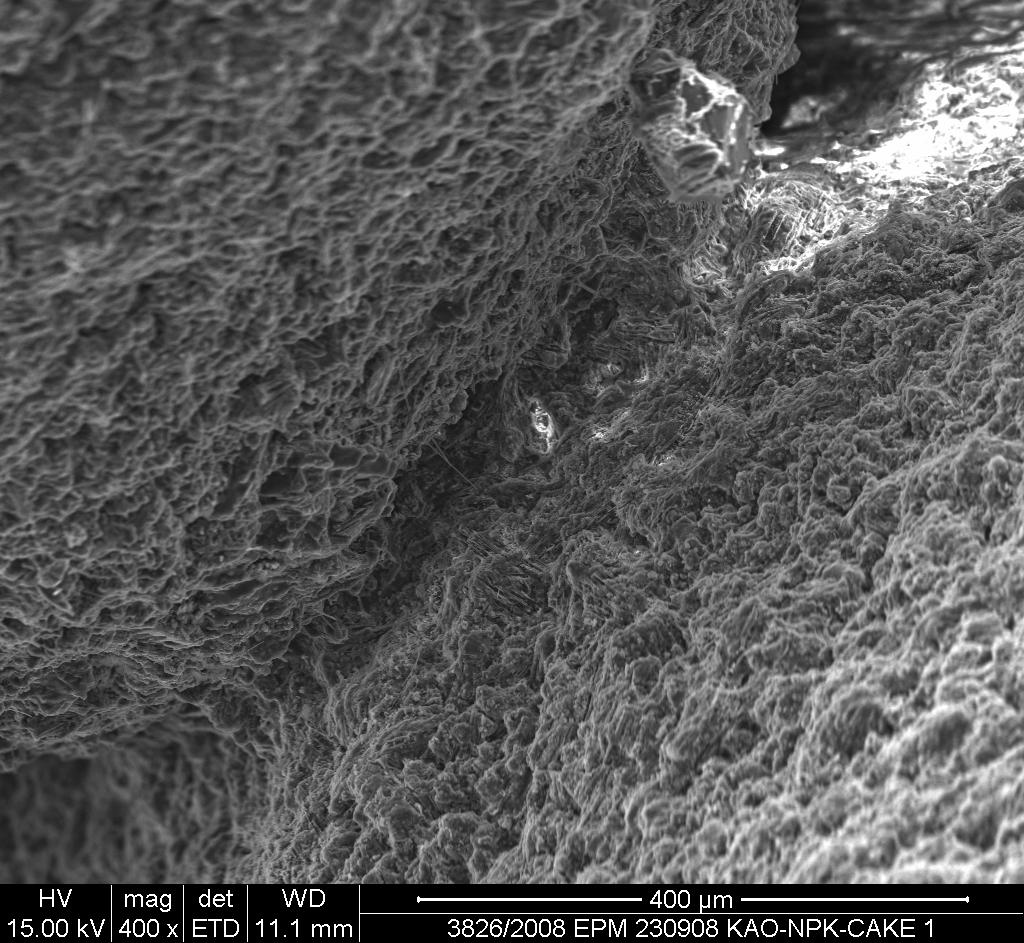
Center [IFDC]), where a sample of fertilizers is poured on the top of the tower while an air fl ow passes from the bottom to the top.2 This process can be applied several times. The difference in weight between the beginning and the end determines the quantity of dust. Another method is to sieve the fertilizer sample, generally within the range of 0.5 – 1 mm. Prior to sieving, abrasion can be applied in a rotary drum, with the possibility of using Figure 4. SEM images of two examples of crystal formation on a granule’s surface, where metal balls depending on the type of the crystals have a needle shape that promotes dust formation. fertilizer (Method IFDC S-116).2 The quantity of dust formation is determined by the weight difference before and after the process. Figure 6 shows one of Kao Chemicals Europe’s rotary drums being used to carry out this test. This method can be applied to the same coated fertilizer sample at different times following treatment, in order to measure the performance of the coating agent over time. In addition to dust quantity, another important parameter is dust particle size distribution. Small particles remain suspended in the air, creating clouds that can travel kilometres away and affect urban areas, for instance. The company performs particle size measurement using laser diffraction equipment (Mastersizer 2000 from Malvern) in a cell where powder is dispersed in a solvent (Figure 7). Figure 5. SEM images of two caked NPK granules. A general view and a detail of the intersection between both granules.
Dust control additives
Depending on the main reason for dust generation – morphology of the granules (high abrasion); climatic conditions (moisture absorption or phase transition changes); post-reactions; caking tendency; or the effect of anti-caking additives – the company can propose different approaches to solve or at least minimise the problem.
Abrasion mitigation
When an irregular surface is the main problem, additives with binding properties are needed in order to minimise the impact of the abrasion caused by handling the granules, as well as additives with a solid coating layer with high fl exibility or a liquid coating layer with high viscosity at room temperature. Figure 8 shows different anti-dusting additives that minimise the abrasion impact in granular monoammonium phosphate (MAP). Protection increases with a higher melting point and viscosity as well as a higher binder content. Results from a 0.5 mm sieving process followed by an abrasion test are shown.
Moisture absorption mitigation
When moisture absorption is the main reason for dust generation, additives must be highly hydrophobic so as to avoid water penetration into the granule. Figure 9 shows the results from the treatment of an NPK fertilizer
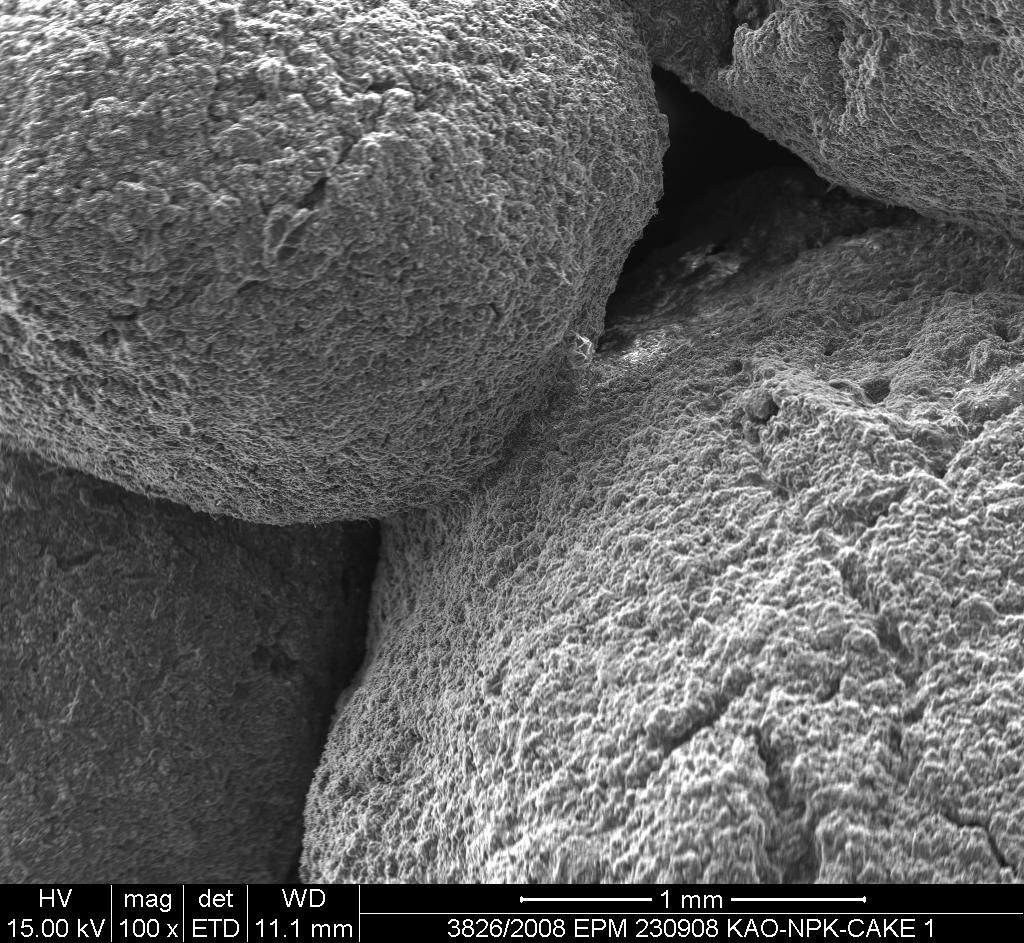
with different additives, with and without the addition of talcum.
Treated samples were placed in Petri capsules and subjected to conditions of 20˚C and 70% relative humidity for 15 hours. Moisture absorption was measured by the difference in weight. Later on, the samples were placed in a chamber at 40˚C and low humidity for 24 hours. Afterwards, a 0.5 mm sieving test was performed to measure dust formation.
The most hydrophobic additive that had been developed (S-100) had the lowest dust generation. In fact, there is a correlation between moisture absorption and dust formation.
Post-reactions mitigation
If there is a high mobility of salts within the granules due to a high water content, this promotes a greater number of post-reactions and more dust formation in turn. When post-reactions are one of the main issues, Kao proposes the use of internal additives that catch free water content, resulting in a reduction of the salts’ mobility within the granules and reducing the progression of post-reactions. These internal additives simultaneously increase granule cohesion as well.
This solution is particularly recommended for NPK fertilizers with serious post-reaction problems. This treatment is generally combined with a suitable external coating treatment.
The company advocates an integrated treatment using two coating drums. In the fi rst coating drum, the anti-dusting additive is applied and, later, an anti-caking additive is applied in the second drum; talcum can be also added in the second drum.
Figure 10 shows a process scheme of the integrated treatment.
Caking tendency and anti-caking additive effects mitigation
Dust formation generated by caking can be easily reduced through the use of suitable anti-caking additives. A wide range of additives can be offered, depending on the fertilizers’ composition.
Additive selection is very important for minimising the caking tendency and the possible formation of dust due to lump crushing. Furthermore, anti-caking formulations can promote dust formation if the surfactants in the formulations are not suitable. A deep knowledge of surfactants and fertilizers’ compatibility with salt is required to avoid dust generation.

Figure 6. Rotary drum for abrasion test.
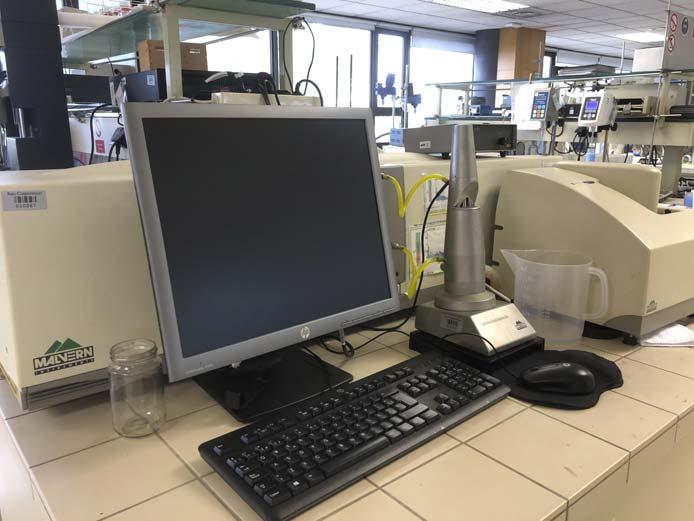
Figure 7. Mastersizer 2000 used to measure particle size distribution of the dust released from fertilizers.
Figure 8. Dust evaluation by sieving at 0.5 mm and abrasion in a rotary drum of a monoammonium phosphate treated with different Kao additives.
New additives for a more environmentally-friendly world
At present, standard coating additives generally contain some components that are not biodegradable – such as mineral oils – and some other ecotoxic ones, such as fatty amines. However, more sustainable additives, such as Kao’s eco-friendly dust control additives, can become an effi cient alternative to regular coating agents by offering a vegetable origin, high biodegradability and low eco-toxicity in all the components present in the formulations.

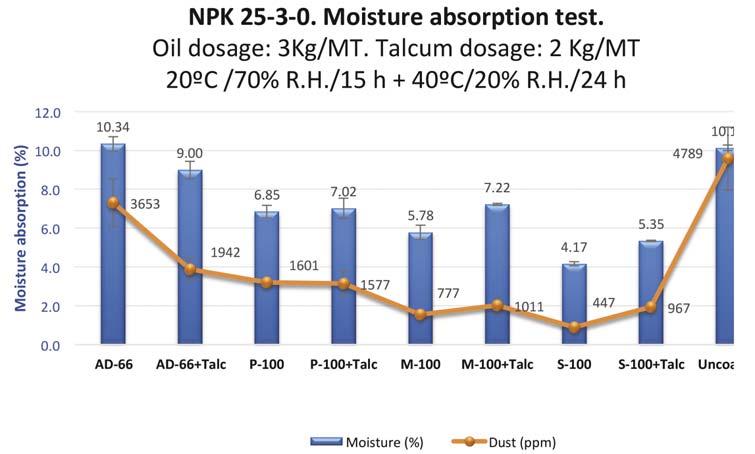
Figure 9. Moisture absorption evaluation in climatic chamber of an NPK treated with different additives, with and without talcum.

Figure 10. Scheme of double treatment process.
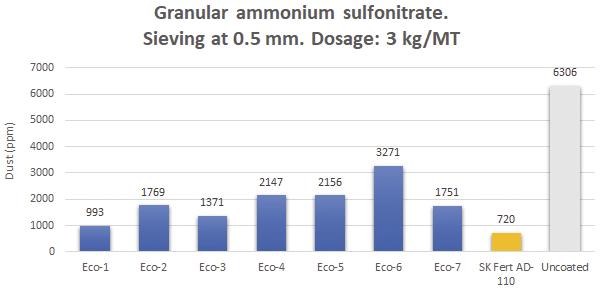
Figure 11. Dust evaluation by sieving at 0.5 mm of an ammonium sulfonitrate treated with different eco-friendly prototypes.
Figure 12. Moisture absorption evaluation in climatic chamber of a NPK treated with different eco-friendly prototypes.
To demonstrate the applications of these new additives the remainder of the article will focus on some of the issues that have been previously discussed: abrasion and moisture absorption. Performance levels will be compared to standard additives.
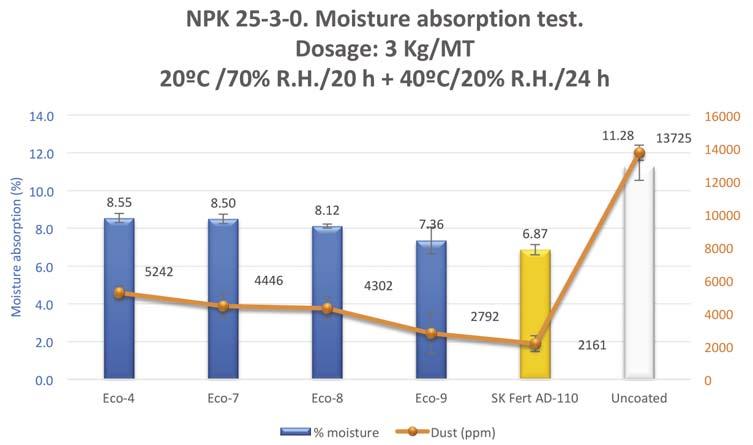
Abrasion mitigation
Figure 11 shows the formation of dust from an ammonium sulfonitrate treated with several eco-friendly prototypes based on vegetable derivatives (blue bars) versus a standard anti-dusting treatment, SK Fert AD-110 (orange bar). Some formulations can be seen to have a good performance, although it is not easy to reach standard anti-dusting treatments levels.
The Eco-1 prototype presents a dust formation value similar to the standard reference. Kao is engaged in a continuous process of developing better anti-dusting treatments in the context of abrasion mitigation.
Moisture absorption mitigation
Figure 12 shows the moisture absorption values of one fertilizer (NPK 25-3-0) treated with several eco-friendly prototypes based on vegetable derivatives (blue bars) versus a standard anti-dusting treatment, SK Fert AD-110 (orange bar). The fertilizer was submitted to high humidity conditions in a climatic chamber.
The test was similar to the test discussed earlier in the article, in which treated samples were placed in Petri capsules and subjected to conditions of varying temperature and humidity. Again, there is a correlation between moisture absorption and dust formation. In this case the values closer to SK Fert AD-110 were obtained with the Eco-9 prototype.
Additives for organic farming fertilizers
An emerging technology in eco-friendly additives are anti-caking and anti-dusting agents for organic farming fertilizers that require special components in their formulations.
Kao is also working to incorporate these kinds of additives into its portfolio. The preliminary results are promising.
Conclusions
In summary, it can be concluded that dust control is not an easily solvable problem in the context of granular fertilizers. As has been explained in this article, several factors can lead to its formation. But if the main reasons for each case can be understood, then it becomes possible to minimise the impact with specifi c solutions.
Due to the fact that some of the solutions are based on surface treatment of organic additives on the granules’ surface, the environmental impact needs to be minimised and sustainable alternative solutions need to be proposed – this is the main challenge for the coming years.
References
1. United Nations Industrial Development Organization and
International Fertilizer Development Center, Fertilizer Manual (1998). 2. RUTLAND, D.W., Manual for Determining Physical Properties of
Fertilizers (1993).






